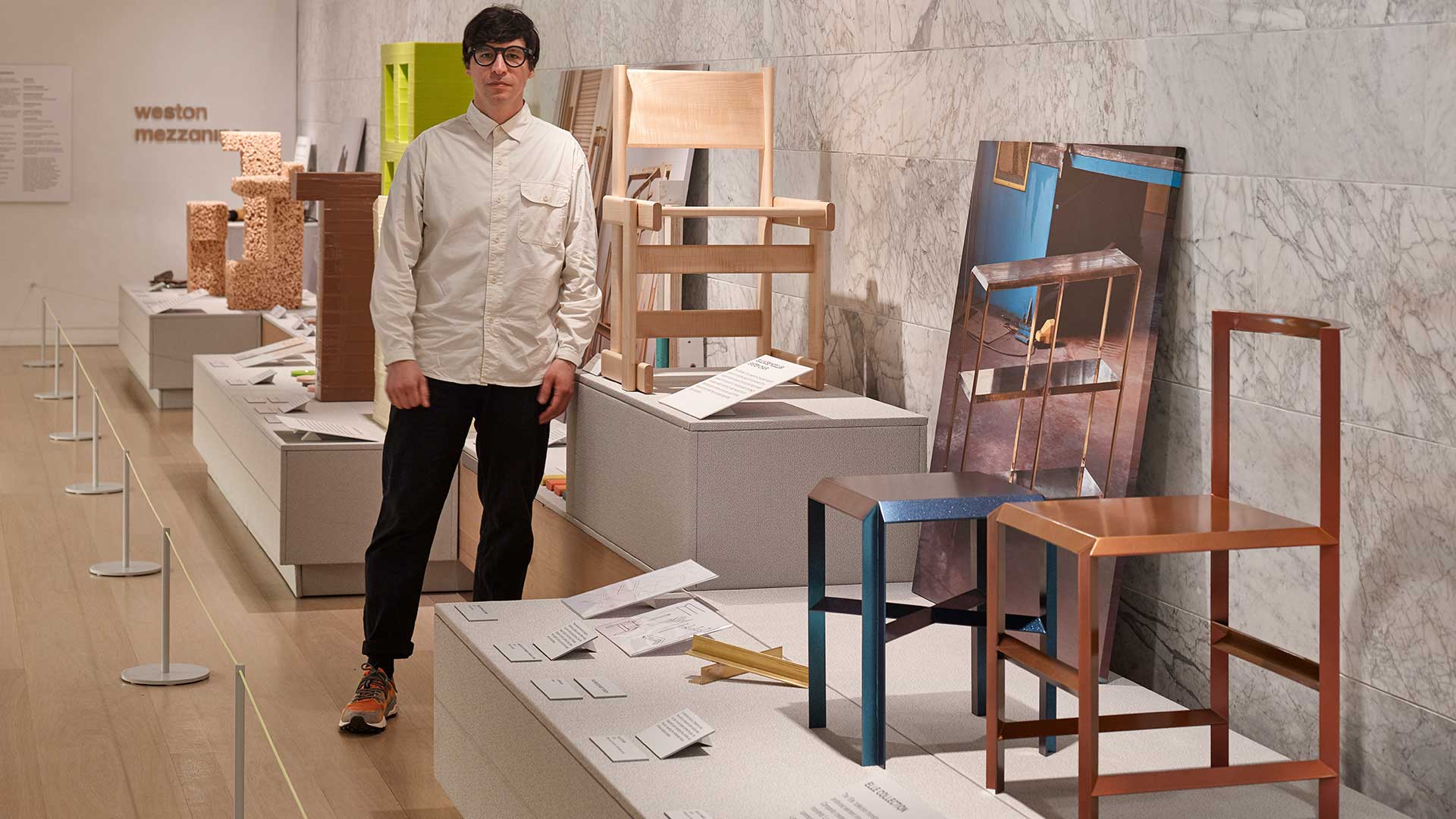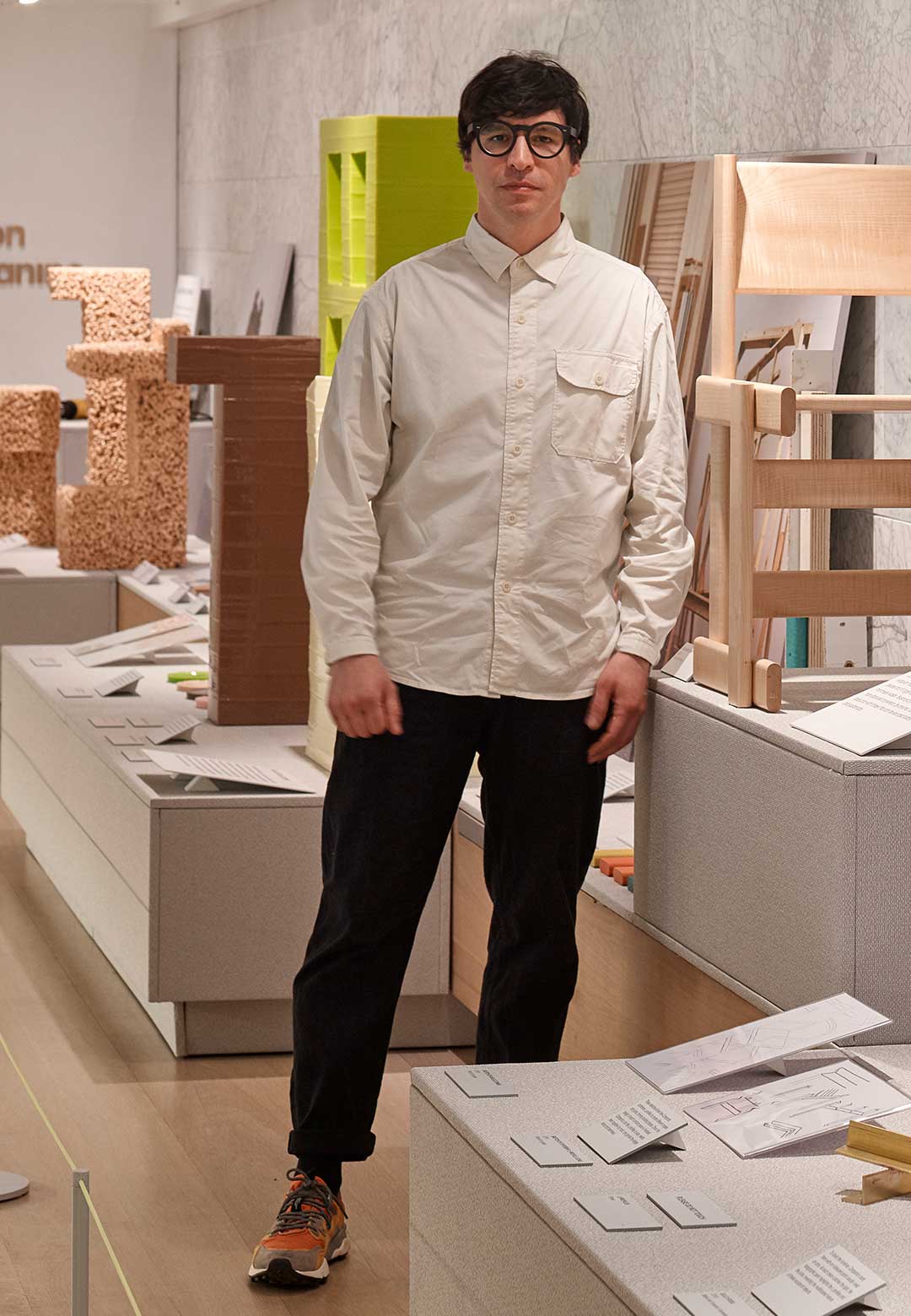Resourceful waste material experimentation and sustainable design ideologies articulate the ‘visually arresting’ works of London-based Italian designer and maker Marco Campardo, the second recipient of the prestigious award, ‘The Ralph Saltzman Prize’, as announced by the Design Museum, London. The annual prize aims to celebrate and support emerging product designers in recognition of late American textile designer Ralph Saltzman’s design legacy, through a bursary and a dedicated solo show at the Museum. Launched in November 2021 and created by Lisa Saltzman (Ralph Saltzman’s daughter) on behalf of the Saltzman Family Foundation, the Prize reflects the Design Museum’s underlying commitment to championing new talent and nurturing the development of a ‘vibrant design sector’. Campardo succeeds Nottingham-based product and furniture designer Mac Collins, who was the inaugural Prize winner in 2022.
Prior to relocating to London to focus on his passion for product design, sustainable materials, and investigating design's industrial processes, Campardo had a career as a graphic designer in Venice. ‘Shaping materials into domestic objects,’ he conceives objects, exhibitions, and site-specific installations, with a particular interest in manufacturing and material experimentation as a form of critical practice, finding educative routes to explore wider narratives about culture, materiality, identity, and authenticity.
"I would describe my design philosophy as being 'process driven'. I am not interested in drawing shapes, but in shaping processes that then determine an object’s shape. I’m definitely not a draughtsman. I always start with a material or a forming process that I’m interested in and from that, I try to develop and bring an object to fruition. I am interested in design that is a result of deep research and knowledge of processes, materials and histories of design," Campardo tells STIR in an exclusive interview.
His works of sustainable design find genesis in hands-on experimentation and research, in a bid to question the very nature of contemporary models of production, transforming seemingly ordinary elements into objects sophisticated and bespoke. Despite the simplicity, the capacity of his designs remains a big allure, augmented by his steady experimentation and research into materials. The designer shares with STIR how he came to design somewhat by chance—"it's due to the fact that when I was young, I was quite a restless child. For this reason, my mother decided to send me to a religious school that focused on applied arts. So my first encounter with the word 'design' happened by pure chance. So lucky! After high school, I started to get more and more interested in the world of design. For this reason, I decided to enrol in the BA Industrial Design course at IUAV University in Venice. There, I had the good fortune and the pleasure of meeting teachers such as Michele De Lucchi, Francesco Messina, and Tobia Scarpa, and of studying the culture and processes of design. This approach to teaching has positively influenced and given me a historical understanding of design which is a crucial part of my practice today."
“(My) research seeks to subvert or adapt industrial manufacturing processes to propose an alternative to standardised, mass production. The final result of this process is aesthetically and conceptually refined objects, whose final form is determined by the very process of making. Playing with high-end and lo-fi methods and materials, (my) projects can be seen as a commentary on the value of making and craftsmanship,” relays Campardo who, before establishing his practice in 2019, carried a design approach shaped through a decade-long work with M–L–XL and Tankboys, two multidisciplinary studios he co-founded in Venice, Italy.
"I’m a very curious person, so manufacturing and materials are first of all interesting matters for me. I like to discover and understand as many as possible ways of forming the objects around us: how they are made, why they are made in such a way, what that tells us about our society, our knowledge of materials, and so on. In this sense, most of the time, my approach to design begins with trying to produce something in which the final aesthetic is the result of a special method or process. Somehow, my design celebrates the process itself instead of following a certain aesthetic or decoration. The aim here is to transmit a certain kind of knowledge - questions about why things are made the way they are, and how we may question certain ways of making things, which is particularly relevant currently. Usually what I try to do is to emphasise the beauty of a specific material. That’s why most of the time my objects are made of one single material. Then once I’ve defined the shape and the process, I try to understand what colour palette or type of finishing might emphasise at best the shape and the surface of the object," he adds.
“Marco is a fitting winner of the Prize. His work is very of the moment and visually arresting. He uses a lot of waste material and shows a clear sustainability narrative. His idea of reusing and the focus on sustainability is utterly compelling. My father was doing this over twenty years ago, so he is continuing that legacy,” shares Saltzman.
“We are delighted that Marco has won this year’s Saltzman Prize. His practice spans an impressively diverse range of approaches, including inventive uses for waste materials. The way he creates small-scale versions of industrial processes is particularly intriguing. Whatever his process, the outcomes are always alluring,” commented Justin McGuirk, Chair of Judges for The Saltzman Prize, and Chief Curator at the Design Museum.
For the 2023 edition of the Prize, five established designers each proposed a young designer currently making waves in the field of product design —the shortlisted designers included Marco Campardo (nominated by designers Edward Barber and Jay Osgerby of London-based industrial design studio Barber Osgerby); Rio Kobayashi (nominated by multidisciplinary English designer Bethan Laura Wood); Joseph Y. Ewusie (nominated by multi-disciplinary artist and designer of British-Nigerian heritage Yinka Ilori); Simon Ballen Botero (nominated by British furniture and interior designer Ilse Crawford, CBE); and Timi Oyedeji (nominated by British industrial designer Jon Marshall).
Designers Edward Barber and Jay Osgerby who nominated Campardo to enjoy a diverse body of work that spans industrial design, furniture design, lighting and site-specific installations as well as galleries and public commissions such as the 2012 London Olympic Torch and projects for the Royal Mint.
The nominees were invited to present their work and design philosophies to a selection panel including the museum’s directorate and members of the Curatorial Committee, along with Lisa Saltzman. “All the emerging designers are trying to point a new direction for design, either by supporting the green transition, through technical innovation or by presenting compelling design ideas,” highlights the Design Museum.
Campardo on becoming the second recipient of The Ralph Saltzman Prize expressed his joy and honour by saying, “Having moved to London from Italy and setting up my practice in 2019, the fact my work has been recognised by the judging panel is extremely humbling, as well as an encouragement for the future development of my work. The fact that the Design Museum has decided to reward work that is often speculative and sits somewhat outside the canon of industrial design, is perhaps a testament to the richness of the contemporary design landscape. I would also like to thank Ed Barber and Jay Osgerby for nominating me for this prize, giving me this unexpected but incredibly exciting opportunity to showcase my work to the wider public, and to Lisa Saltzman for making it all possible. I was extremely surprised and incredulous to have been nominated by Barber Osgerby, one of the most successful design practices in the world. It’s a huge recognition and gives me courage on those days when my experiments may fail, and I am quite unsure of what I’m doing —it still means I am heading in the right direction. In Alan Fletcher’s words: “I don’t know where I’m going… but I’m on my way”."
A key design figure as the co-founder and president of Designtex, Ralph Saltzman’s curiosity, philanthropic ideals, and collaborative spirit remains palpable in the legacy of innovation he leaves behind, and in the company, he founded six decades ago. Saltzman, who passed away in 2020, is remembered as a textile innovator, facilitator of collaborations, and mentor to bright, young designers, as reflected in his Foundation. Designtex's development of sustainable textiles and the partnership that emerged between William McDonough and chemist Michael Braungart won First Prize in the International Design Sense competition at the Design Museum in 2000.
“Marco’s work looks to tap into William McDonough’s notion of cradle-to-cradle design, the notion by which design and production of products of all types can be done in such a way as that at the end of their life, they can be truly recycled and reused,” says Saltzman, who created The Ralph Saltzman Prize in collaboration with the Design Museum.
“I created the Ralph Saltzman Prize as a legacy to my father. My father was an innovator and a pioneer who had a keen eye, and great taste and he thought outside the box. He was a trailblazer, renowned for his creativity. He was a visionary, and exceptionally innovative. He was an incredibly kind and generous man and the best father imaginable. I miss him more than I can say but I know this prize is an initiative that will endure. The Ralph Saltzman Prize is a way to give young designers an opportunity, an honorarium and a show,” shares Saltzman about her father, after whom the Prize is named. “My mother encouraged my father to start his own company and was supportive from the beginning and throughout. His aesthetic and love of design was intoxicating, (and) the prize is inspired by his passion and commitment to great design,” she adds.
As a commitment to the future of good design, Campardo’s work will be featured in a free display open to the public from February 2 – April 3, 2023, at the Design Museum, and he will also receive a £5,000 bursary to support his work. London’s Design Museum will also host an evening with the winner on February 21, 2023, where Campardo will be in conversation with Ed Osgerby from Barber Osgerby, with the discussion chaired by the Design Museum’s Senior Curator, Rebecca Lewin. Campardo shares with STIR, "I had the honour to work with a talented and young curator Esme Hawes. She understood from the beginning the importance of process in my practice, especially for the educational aspect, allowing students who perhaps may visit the exhibition to understand the process that has generated a specific outcome. That’s why we decided to show, together with the results, the processes of five different projects that best represent my attitude and philosophy."
So, what is NEXT for Campardo? "On the occasion of the Salone del Mobile 2023, I’ll present at Fuorisalone a collection of seats commissioned by AMO, a new platform that celebrates the handmade. The project emerged from a decades-long friendship between Ambra Medda and Veronica Sommaruga, who met as neighbours in New York. It brings together a kaleidoscopic array of objects from different eras and cultures – all united through their exploration of colour, form and material," he says.






 Sign in with email
Sign in with email










What do you think?